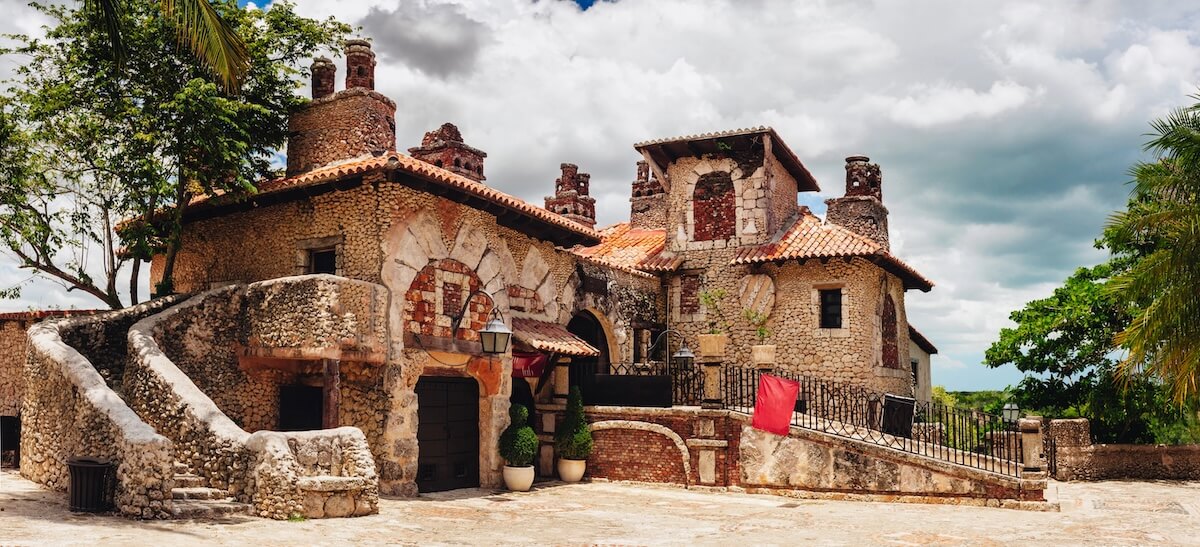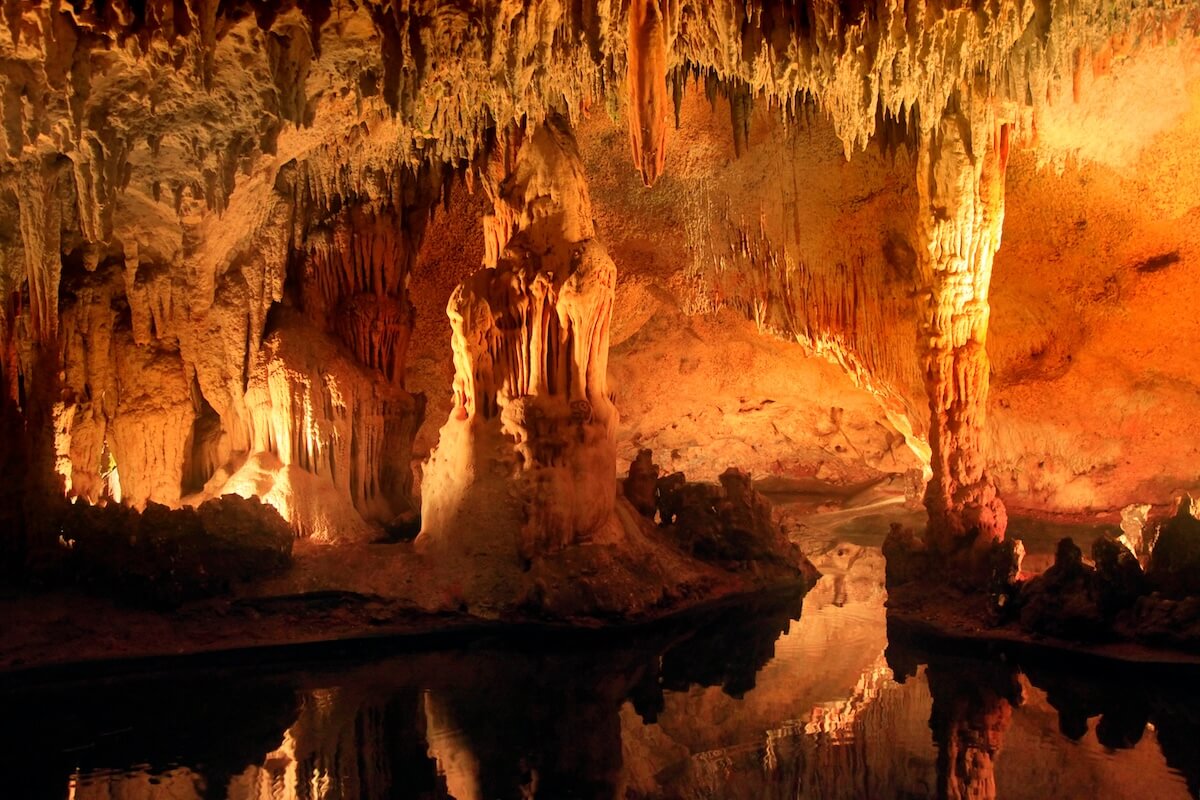5 Easy Drives from Santo Domingo
Best time to travel: Dry Season: October-June; Festival Season: June to August
Budget: $125 per day
I love Santo Domingo’s mix of colorful colonial streets and open-air cafés as much as anyone, but sometimes you just need to hit the road and see what’s beyond the city walls. In under two hours’ drive you can swap traffic for powder-soft sands at Boca Chica (just keep in mind that the beach vendors and meseros can get pretty insistent—don’t be shy about a polite “no, gracias”), wander a painstakingly crafted 16th-century–style village perched above the Chavón River, duck into an 800 m limestone cave studded with real Taíno rock art, or lose yourself in the winding alleys of Haina’s massive produce market.
Each of these four day-trips proves that the Dominican Republic’s real magic isn’t far from Santo Domingo—you’re just minutes away from deserted turquoise bays, echoing caverns, hilltop vistas, and markets brimming with fresh mangoes and pastelitos. So crank up the radio, fill your tank, and get ready to discover a side of the island that most visitors never see—adventures that start the moment you leave the city behind.

Los Tres Ojos & Parque Nacional Los Haitises
A pair of geological wonders: three crystal-clear sinkhole lakes under open-air caves, then a boat ride into a mangrove archipelago teeming with birdlife and ancient Taíno petroglyphs.
Drive Time & Distance
- Los Tres Ojos: 9 km, ≈ 15 min from central Santo Domingo
- Sabana de la Mar (jump-off for Los Haitises): 104 km, ≈ 1 h 45 min
- Boat transfer to Los Haitises: 30 min each way
Why Visit
- Los Tres Ojos: Wander a trio of sinkhole lakes beneath limestone caverns, their emerald waters reflecting dramatic stalactites.
- Los Haitises: Glide through mangrove tunnels, spot frigatebirds and herons, and admire pre-Columbian rock art on hidden islets.
Who Will Love It
- Nature lovers and birdwatchers
- Kayak or boat-tour enthusiasts
- History buffs intrigued by Taíno heritage
Insider Tips
- Book an eco-certified boat operator in advance—groups are small and guides point out rare orchids and petroglyph sites.
- Bring binoculars and waterproof sandals; wear quick-dry clothes and apply insect repellent.
- Pack snacks and plenty of water; there are no facilities once you hit the park’s mangrove channels.

Boca Chica & La Caleta Underwater Museum
Boca Chica’s bay is enclosed by a 500 m coral reef, creating one of the Caribbean’s calmest natural “pools,” while La Caleta Underwater National Park—established in 1986—protects some 11.4 km² of reefs, shipwreck habitats, and Taíno artifacts in its Ethnological Museum.
Drive Time & Distance
- Boca Chica Beach: 34 km, ≈ 29 min
- La Caleta Park: 20 km, ≈ 18 min
Why Visit
- Swim in waist-deep, reef-sheltered waters ideal for families and beginners
- Snorkel over artificial wrecks and vibrant coral gardens
- Learn Taíno history at the on-site Ethnological Museum
Who Will Love It
- Families and novice snorkelers
- Marine-life enthusiasts
- Culture buffs interested in pre-Columbian archaeology
Insider Tips
- Vendors and meseros at the beach can be very pushy—politely but firmly decline extras you don’t want to avoid feeling uncomfortable
- Arrive by 8 AM to avoid tour groups and midday sun
- Rent gear from licensed beach vendors and support local cooperatives
- Use reef-safe sunscreen and bring a refillable water bottle

Altos de Chavón
A meticulously crafted 16th-century Mediterranean-style replica village, conceived in the 1970s by Italian set designer Roberto Coppa and funded by industrialist Charles Bluhdorn—every hand-placed stone evokes Old-World charm.
Drive Time & Distance
- 120 km, ≈ 1 h 30 min
Why Visit
- Wander cobblestone streets lined with artisan workshops and galleries
- Explore the Regional Archaeological Museum and climb to the Grecian amphitheater for river views
- Sip coffee at hilltop cafés overlooking the Chavón River
Who Will Love It
- History & architecture enthusiasts
- Art and design students
- Photographers seeking dramatic backdrops
Insider Tips
- Combine with Casa de Campo’s botanical gardens next door
- Check the amphitheater schedule for live concerts or cultural events
- Purchase ceramics and leather crafts directly from the makers

Cueva de las Maravillas (Cave of Wonders)
An 800 m limestone cavern discovered in 1926, showcasing over 500 authentic Taíno pictographs—some dating to AD 650—along well-lit walkways beneath soaring stalactites.
Drive Time & Distance
- ≈ 90 min via Carretera San Pedro–La Romana
Why Visit
- Marvel at centuries-old indigenous rock art in vivid red and black pigments
- Stroll past the nearly perfect “Water Mirror” reflecting pool
- Escape the heat in consistently cool 18–20 °C cave air
Who Will Love It
- Archaeology and history buffs
- Adventure travelers seeking unique natural wonders
- Photographers drawn to subterranean landscapes
Insider Tips
- Wear non-slip shoes and bring a light jacket
- Book guided tours online to secure your desired time slot
- Learn basic Spanish (“¿Dónde está la cueva?”) for smoother check-in

Río Haina Market Crawl
Mercado Municipal de Haina weaves through narrow alleys lined with hundreds of stalls, forming one of the region’s largest wholesale hubs for fresh produce, meats, spices, and authentic street-food snacks.
Drive Time & Distance
- 17 km, ≈ 18 min
Why Visit
- Sample sun-ripened mangoes, yuca frita, pastelitos, and freshly roasted coffee
- Watch merchants haggle and pack bulk shipments bound for Santo Domingo
- Immerse yourself in everyday Dominican life away from tourist circuits
Who Will Love It
- Foodies and culinary explorers
- Cultural anthropologists and market photographers
- Budget travelers hunting local bargains
Insider Tips
- Go between 7–11 AM for peak produce freshness
- Carry small bills (50–200 DOP) and coins—most vendors are cash-only
- Greet sellers with “Buenos días” to build rapport
More things to discover around Santo Domingo
Practical travel tips for Santo Domingo
Which language is spoken in the Dominican Republic?
The offical language is Spanish. You'll find people speak some English in the resort areas.
What is the offical currency in the Dominican Republic?
The currency used in the Dominican Republic is the Dominican Peso, often symbolized as "RD$" or simply "RD." The currency is further divided into smaller units known as centavos.
What is the best time to visit Santo Domingo?
The best time to visit Santo Domingo, the capital of the Dominican Republic, largely depends on your preferences for weather, crowds, and activities. Here are some considerations for different times of the year:
December to April (Dry Season):
- This is the peak tourist season in Santo Domingo due to the pleasant weather with lower humidity and minimal rainfall.
- Ideal for outdoor activities, exploring the historic sites, and enjoying the beaches.
- Expect higher prices for accommodations and more tourists during this period.
May to November (Rainy Season):
- The rainy season brings warmer temperatures and occasional heavy rainfall, particularly in September and October.
- Prices for accommodations and flights tend to be lower, making it a budget-friendly time to visit.
- While rain can be a drawback, the city's lush greenery and gardens are at their most vibrant.
Late February to Early March (Carnival):
- If you're interested in cultural festivities, consider visiting during the Carnival season, which features colorful parades and celebrations.
- Prices may be higher during this period, and accommodations can fill up quickly.
Avoid Hurricane Season (June to November):
- Keep in mind that the Caribbean hurricane season officially runs from June to November. While the Dominican Republic isn't as prone to hurricanes as some other Caribbean destinations, it's still a risk to be aware of.
Ultimately, the best time to visit Santo Domingo depends on your priorities. If you prefer pleasant weather and are willing to deal with larger crowds and higher costs, the dry season from December to April is the top choice. However, if you're looking for budget-friendly options and can tolerate occasional rain, the rainy season can offer a more affordable and less crowded experience.
Is Santo Domingo safe for travelers?
Public Transport in Santo Domingo
Buses: Santo Domingo has an extensive bus network operated by different companies. These buses are often crowded and may not be the most comfortable option for tourists, but they can be a cost-effective way to get around the city. Be prepared for traffic congestion, especially during peak hours.
Metro: Santo Domingo has a modern and efficient metro system, which is a convenient way to travel within the city. The metro operates two lines that connect various neighborhoods and key points of interest. It's a safe and affordable mode of transport.
Taxis: Taxis are readily available in Santo Domingo. It's essential to choose licensed taxis, which are identified by their green license plates and a taxi company logo on the door. Negotiate the fare before starting your journey or ensure the driver uses a meter.
Uber and Ride-Sharing: Uber and other ride-sharing services operate in Santo Domingo, providing a convenient and often safer alternative to regular taxis. Prices are generally reasonable, and the app provides a transparent way to calculate fares.
Car Rentals: If you prefer more autonomy in your travels, you can rent a car. However, traffic in Santo Domingo can be congested, and parking can be a challenge in some areas.
Motoconchos: Motorcycle taxis, known as "motoconchos," are a common sight in Santo Domingo. While they are a quick way to get around, they can be riskier than other forms of transportation, especially for tourists unfamiliar with local traffic.
Guaguas: Guaguas are small buses or vans that operate on fixed routes. They are a low-cost option, but they can be crowded and less comfortable.
Omsa Buses: The Oficina Metropolitana de Servicios de Autobuses (OMSA) operates a fleet of government-owned buses that serve various routes in Santo Domingo. These buses are generally safe and affordable.
Cyclotaxis: In some areas, you may find cyclotaxis, which are pedal-powered tricycle taxis. They can be a fun and eco-friendly way to explore certain neighborhoods.
Can I drink tap water in the Dominican Republic?
Travelers to the Dominican Republic are generally advised to avoid drinking tap water. While some urban areas may have treated water that is safe for locals, the quality and treatment of tap water can vary greatly across the country.
To avoid the risk of waterborne illnesses, I highly recommend bringing a self-cleaning bottle.
What's the biggest challenge for the conscious traveler?
Tourism leakage: The Domican Republic is a tropical paradise that's adored by tourists worldwide, but it has a problem that's hidden from sight - tourism leakage. This phenomenon refers to the loss of revenue that occurs when international hotel chains capture a large chunk of tourist dollars, leaving very little money behind to benefit the local economy. If you're among the millions of visitors who flock to the islands every year, there's a simple way to help mitigate the effects of tourism leakage: support Dominican-owned hotels, shops, and restaurants. By doing so, you can put your money where your heart is - and give the people of the Domican republic a chance to thrive. So don't be shy about seeking out local businesses on your next vacation. Your decision to keep tourism dollars within the country could make a world of difference.
Sex Tourism:
Engaging in activities that exploit vulnerable women directly supports the sex trafficking industry, endangering the lives of young girls and women.
Wildlife
Likewise, interacting with wildlife should be done responsibly; feeding wild animals can lead to their harm or demise. Don't ever touch starfish!
Beach access
While the Domican Republic is known for its beautiful beaches, there have been some issues with access to these public spaces. In recent years, many resorts and private properties have restricted access to certain parts of the beach, making it incredibly difficult for locals to maintain their life and right to the sea. Support public beaches and say no to all-inclusive tourism!
Trash
Make sure to bring a foldable food container and cutlery with you! The amount of waste caused by food sold on the street is incredible.
Sunscreen
Make sure to protect the marine life and bring reef-friendly sunscreen!
Packing List Caribbean
As you see, there are plenty of things to experience in the Dominican Republic. To come fully prepared, check out my packing list for Jamaica, which includes everything from eco-friendly toiletries to sustainable fashion and even the coolest travel gadgets!
Places to visit in the Caribbean
Best places to stay in Jamaica
Where to stay in Jamaica- Saint Lucia at a Glance - Key areas - My Top Hotel Choices - North - South and Soufiere - East Coast - Castries - Budget Stays - Sustainable Stays - During Carnival - For couples -Beach StaysDuration: at least 3 weeks Best time to travel:...
Where to stay in St. Lucia
Where to stay in Saint Lucia- Saint Lucia at a Glance - Key areas - My Top Hotel Choices - North - South and Soufiere - East Coast - Castries - Budget Stays - Sustainable Stays - During Carnival - For couples -Beach StaysDuration: at least 3 weeks Best time to...
Island Hopping St. Vincent
Join me as I island-hop through Saint Vincent’s gems—from Bequia to Union Island—in under an hour on budget-friendly boat rides that unveil hidden beaches, local flavors, and Caribbean charm.
Things to do in Bequia
Duration: at least 5 days Where to stay: The Liming Bequia Best time to travel: Dry Season: October-June; Festival Season: June to August Budget: $125 per dayBequia, the second-largest island in St. Vincent & the Grenadines, greeted me with an effortless calm the...
Things to do in Kingstown, St. Vincent and the Grenadines
Join me in Kingstown, St. Vincent as we wander the historic Botanical Gardens, clamber up Fort Charlotte, haggle at the bustling market, chase perfect sunsets, and savor local eats.
Chasing beaches in Portland, Jamaica
Craving sun-kissed days? My guide to the best beaches in Portland, Jamaica reveals Winnifred’s laid-back charm, Frenchman’s Cove’s dreamy lagoon & other local gems—straight from my own sandy-footed adventures.
15 Day Trips from Kingston | Mountains, Rivers & Beaches
When the hustle and bustle of Kingston becomes too much, escaping for a day-trip to one of the island’s nearby gems is the perfect remedy. Here are my favorite day trips from Kingston
Uncover the Hidden Treasures of Trinidad: Day Trips from Port of Spain
Duration: at least one week Budget: $ 150 per day Where to stay: Culture Crossroads Inn or Kapok HotelVisiting Port of Spain and looking for the perfect day trip? As someone who's spent a lot of time exploring this vibrant city and its surroundings, I can assure you...
Exploring the South of Trinidad: A Journey Through Hidden Gems
Exploring South Trinidad felt like uncovering a world of surprises—from the surreal La Brea Pitch Lake to quiet beaches and mouthwatering local flavors. In this guide, I share my personal experiences and travel tips to help you discover the magic too!
Driving in Trinidad: Why It’s Worth the Adventure
Driving in Trinidad gave me the freedom to explore breathtaking views, hidden spots, and remote beaches. In this guide, I share personal tips, favorite routes, and everything you need to know to confidently hit the road!











